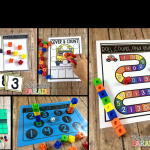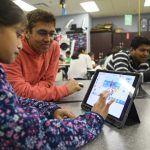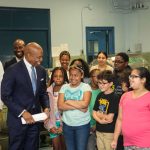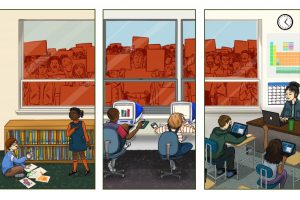
STEM skills equip students to shape the future through innovation and problem solving. As Albert Einstein said, “Imagination is more important than knowledge. Knowledge is limited. Imagination encircles the world.” Grade Link Academy brings STEM to life through immersive cross-disciplinary projects sparking creative potential.
Hands-On Learning
Minds-on engagement inspires budding scientists and thinkers. Grade Link’s hands-on STEM curriculum includes:
- Coding: Program games, animations and apps using Scratch, Python and JavaScript.
- Robotics: Build and program Lego Mindstorm bots completing tasks.
- Engineering: Design structures to withstand “earthquakes” on shake tables.
- Chemistry: Mix edible “potions” illustrating reactions and states of matter.
- Physics: Race balloon rockets and construct circuit boards powering devices.
- Biology: Dissect owl pellets to examine food chains. Grow plants under different light conditions.
Tactile experiments make abstract concepts tangible. Tinkering develops perseverance, creativity and problem-solving abilities.
Integrating Across Subjects
STEM comes alive when organically blended across traditional disciplines:
- ELA: Write lab reports, analyze scientific rhetoric, publish student research findings.
- History: Examine how science shaped history, from the telescope to splitting the atom.
- Math: Practice measurement and data analysis through experiments. Calculate real-world formulas.
- Art: Design infographics displaying scientific concepts. Use microscopes to inspire artworks exploring perspective.
- PE: Apply physics and biomechanics to improve athletic performance.
An integrated approach shows STEM’s relevance while strengthening literacy and critical analysis skills.
Design Thinking Challenges
Grade Link’s design thinking projects teach creative problem solving:
- Identify real issues affecting the community, like food waste or unsafe street crossings.
- Empathize by surveying impacted groups to understand needs.
- Brainstorm solutions. Select the most promising ideas.
- Rapidly prototype concepts with available materials, then test.
- Gather user feedback to refine the design through iterations.
- Pitch final solutions to peers, experts, and community leaders.
This process mirrors how innovators think in STEM fields. Students gain confidence that their ideas can make a difference.
Mentorships
Local professionals volunteer as mentors on STEM projects:
- Engineers guide designing structures and optimizing inventions.
- Web developers assist creating apps and computer programs.
- Scientists explain scientific principles and lab techniques.
- Healthcare workers demonstrate medical devices and treatments.
- Tradespeople demonstrate wiring, woodworking and systems.
Mentors inspire students by revealing STEM career paths while imparting specialist knowledge.
Partnerships
Industry and academic partners provide STEM resources:
- Universities open labs for demos and lend equipment.
- Businesses sponsor robotics teams and offer judges for competitions.
- Museums host interactive engineering events onsite and virtually.
- Libraries loan project materials like microscopes and coding kits.
These coalitions align Grade Link’s STEM curriculum with developing workforce needs to prepare future leaders.
Family STEM Nights
Evenings events engage whole families in discovery:
- Science Fair: Students showcase investigations with mechanisms built from recycled materials.
- Math Carnival: Families navigate stations with puzzles and games illustrating math principles.
- Coding Workshop: Parents and kids team up programming robots through mazes.
- Energy Experiments: Families conduct trials with wind turbines, solar cells and fuel cells.
- Astronomy Night: Peer through telescopes identifying stars and constellations.
Making STEM fun for the whole family spotlights its role in daily life.
Celebrating STEM Diversity
Highlight diverse role models who shatter stereotypes in STEM fields:
- Read biographies about Katherine Johnson, Mae Jemison, George Washington Carver and other trailblazers.
- Design pamphlets profiling women or minority scientists who inspire you.
- Film Grade Link STEM mentors discussing their career paths.
Seeing people who look like them excels in STEM motivates students to pursue their passions.
Grade Link Academy believes every child has inner genius ready to be unlocked. With compelling hands-on STEM programs, outlooks brighten and futures ignite.
















